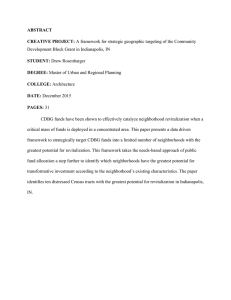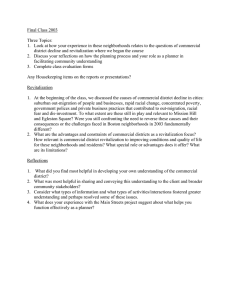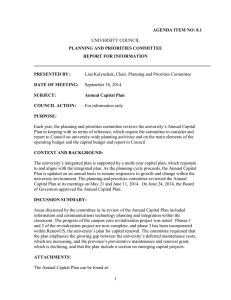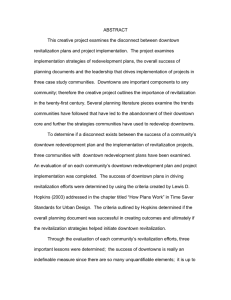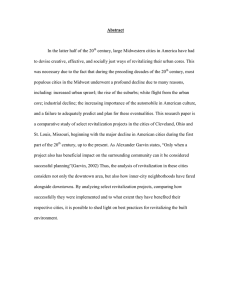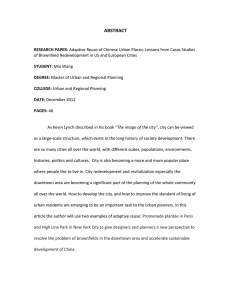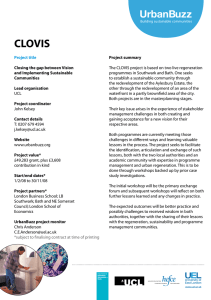Community Revitalization in the United States and the United Kingdom
advertisement
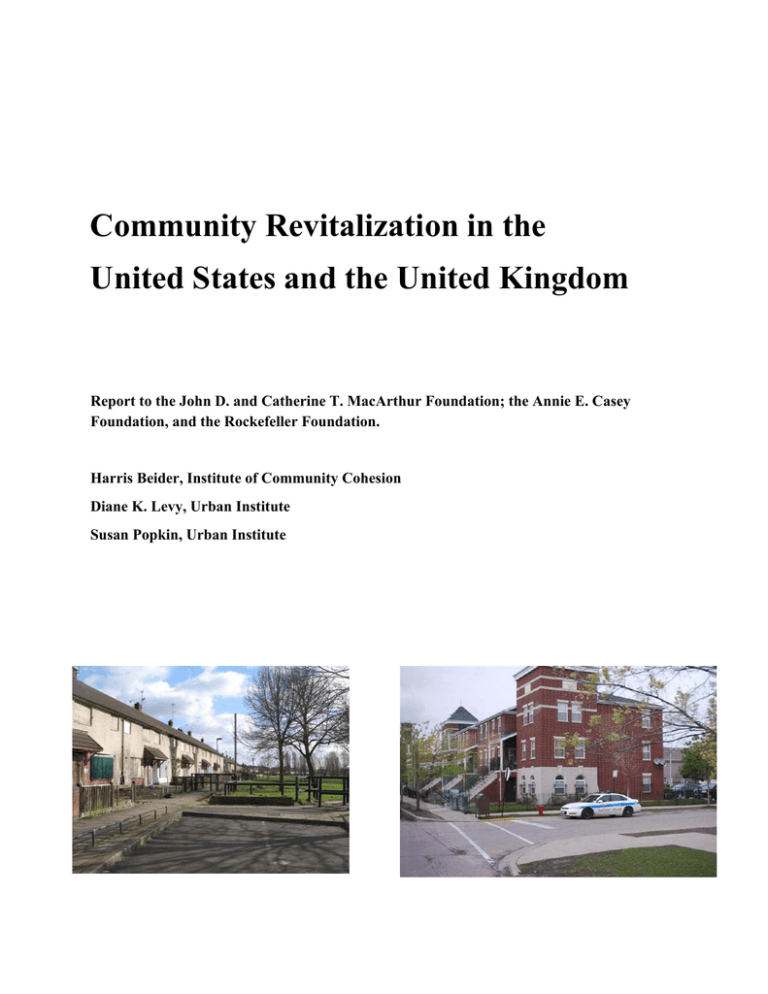
Community Revitalization in the United States and the United Kingdom Report to the John D. and Catherine T. MacArthur Foundation; the Annie E. Casey Foundation, and the Rockefeller Foundation. Harris Beider, Institute of Community Cohesion Diane K. Levy, Urban Institute Susan Popkin, Urban Institute Community Revitalization in the United States and the United Kingdom 2 ACKNOWLEDGMENTS There are many individuals and organizations on both sides of the Atlantic who contributed to this project, making it both possible and enjoyable. There are too many to name here though we include a list of sponsors and participants at the end of the report. We would like to name a few people who deserve a special mention. In the United Kingdom, Satinder Birdi from iCoCo helped with administrative arrangements efficiently and effectively; Eddie Edmead (Aston Pride), Owen Thompson (Clapham Park Homes) and Carl Pearson (Coventry) organized stimulating study visit programs. In the United States, Barika Williams made travel plans, organized events in Washington, DC, and oversaw a number of other arrangements on both sides of the pond while also adding greatly to program substance. Charles Rutheiser and Scot Spencer (Baltimore), Herman Brewer (Chicago), and John Keating (Portland) organized interesting and provocative study visits in their respective cities. American members and friends of the study group at the Lambeth Town Hall, UK: (front) Bryce White, Diane Levy, Susan Popkin, Janice Burgess, Barika Williams, and Angela Meader (UK); (back) Scot Spencer, Herman Brewer, John Keating, Harris Beider (UK), Owen Thompson (UK), Charles Rutheiser, and Roger Williams. Title Page: (L) Existing housing at Wood End, Coventry, UK (R) New housing at Oakwood Shores, Chicago, IL, US Community Revitalization in the United States and the United Kingdom 1. 3 INTRODUCTION There has long been a transatlantic flow of ideas between the United Kingdom (UK) and the United States (US) in everything from cultural trends to political and economic theories and practices. In recent years this flow has included approaches to housing policy, as the public sectors in both countries have turned toward the private sector to help provide affordable housing. This change has been led by policy and practice in the US, where it has occurred to a greater degree. In particular, the US’ HOPE VI program has served as a model for the redevelopment, or regeneration, of housing developments serving very low income families. Characteristics of the model include the use of mixed-financing for the demolition and construction of new housing, private-sector housing developers (both for-profit and not-forprofit) in the construction of new developments that include a mix of deeply subsidized public housing units, moderately subsidized affordable units and unsubsidized rental and homeownership units, and a supportive services component contracted out to other public and/or not-for-profit entities. While this approach to the provision of public and affordable housing has been taking place in the US, there have been efforts underway in the UK to sell social housing units to individual owners and to re-envision community regeneration along the lines of mixedincome communities. It is within this context that Harris Beider of the Institute of Community Cohesion (iCoCo) in the UK and Susan Popkin and Diane Levy of the Urban Institute (UI) in the US developed an innovative 12-month program of work to compare approaches to community revitalization, community cohesion and sustainable neighborhoods in cities across both countries. The project, which began in January 2008, is sponsored by the Rockefeller, MacArthur and Casey Foundations in the US, and Birmingham City Council, Clapham Park Homes (CPH), Coventry City Council, Notting Hill Housing Group and iCoCo in the UK. A hallmark of the program is the inclusion of public and private housing practitioners, private foundations, and policy researchers, which has allowed for rich learning opportunities between the two countries and across professions. Program Components The program included three components: study visits, policy seminars and reports. Community Revitalization in the United States and the United Kingdom 4 Study visits. A group of housing practitioners, policy researchers and foundation staff from the US travelled to Birmingham, Coventry and London in March 2008 to visit regeneration programs and to meet policymakers, practitioners and community activists. The programs are part of the government’s New Deal for Communities (NDC) initiative that supports housing and community redevelopment projects. Sites visited included: • Aston Pride, an NDC community in an area of Birmingham with a majority minority population; • Wood End in Coventry, also an NDC community. It has established a company that will continue NDC-type work once program funding has ended; and, • Clapham Park Homes in South London. Originally an NDC recipient, CPH changed its legal structure to a housing association and is in the early stages of major housing and community revitalization efforts. Practitioners and researchers from the UK visited the US in May 2008 to visit housing and community redevelopment projects in Washington, DC, Baltimore, MD, Chicago, IL, and Portland, OR, meeting with practitioners, local government staff, foundation staff, and community activists. The group toured community development projects with a focus on HOPE VI sites—public housing developments redeveloped with support from the federal HOPE VI housing program. Sites visited included: • Capitol Gateway in Washington, DC. This is a mixed-income HOPE VI development that replaces two public housing developments; • (L to R): Femi Adewole (UK), Harris Beider (UK), Susan Popkin (US), Owen Thompson (UK), and Kate Davies (UK) viewing the Capitol Gateway site plan, Washington, DC, US East Baltimore Development Initiative in Baltimore, MD, a neighbourhood-wide redevelopment initiative that is similar in scope to some of the NDC programs; Community Revitalization in the United States and the United Kingdom • Wentworth Gardens Homes and Oakwood Shores in Chicago, IL. Wentworth Gardens Homes was renovated and will remain public housing whereas Oakwood shores is a HOPE VI development that replaces three public housing developments; and, • New Columbia in Portland, OR, another HOPE VI site. This development increased the total number of housing units and is racially and ethnically diverse. 5 See appendix A for more detailed site descriptions. Policy seminars. Beider and Popkin made presentations at the three US-based policy seminars supported by US foundations and the three UK-based seminars supported by regeneration partners. These were interactive events following the format of a presentation leading to discussion and debate. The seminars provided a framework to explore similarities and differences in approaches to redevelopment and regeneration in the US and UK. Race, regeneration, and the respective roles of the public, private and voluntary sectors were among the topics discussed. Participants included housing practitioners, community activists, academics and representatives from think tanks. Reports. Beider and Popkin each prepared discussion papers for participants on the state of housing programs and policies for disadvantaged households in their respective countries, historical and contemporary factors that have influenced each country’s approach to housing provision, and issues for consideration over the course of the comparative program. In addition, they and Diane Levy (UI) wrote this final program report. Ultimately, the purpose of the exchanges, seminars and reports is to influence policy and practice agendas in the UK and US. Scot Spencer (US) at the policy seminar at Aston Pride, Birmingham, UK Community Revitalization in the United States and the United Kingdom 2. 6 POLICY CONTEXT Cities in the US and UK face similar problems. These include an aging and, in places, obsolete housing stock in need of overhaul or replacement; housing developments isolated physically and socially from surrounding communities; long-distressed neighborhoods that have experienced market pressures that could put the affordable housing stock at risk; disadvantaged residents with such challenges as poor physical or mental health, low educational and training attainment, and substance abuse; and low rates of labor-market participation; and disconnected youth at risk for dropping out of school and engaging in delinquent activities. The responses of the two countries to these challenges reflect key differences in history, racial and ethnic diversity, and the roles of the public and private sectors in the provision of housing. Development of social and public housing. Because of the large-scale destruction of infrastructure, housing and industry in UK cities during World War II, there was a critical need to rebuild quickly. To meet the pressing needs, the national government took on the role of housing provider, rather than turn to the private sector. The new government-built housing stock served people from a range of income groups, including poor, working class, and professional, middle-income households. A combination of reduced public investment in social housing and implementation of the right-to-buy initiative since 1979 has cut the stock from approximately 32 to 18 percent of the total housing stock in Britain (Mullins and Murie 2006). Public housing in the US also had ties to the war; some developments built to house workers in war-related industries during the conflict were converted afterward into public housing. The majority of public housing developments, however, were built to provide low-cost housing to people who needed assistance getting a leg up financially and to provide decent housing to people living in slums that were slated for clearance. Public housing has never made up a majority of the country’s housing stock; public and assisted housing currently accounts for only two percent of all housing in the US (Turner and Kingsley 2008). Racial and ethnic diversity and race relations. The UK remains a majority white country, although it has become more diverse since 1945 as emigration increased from former colonies in the Indian sub-continent and the Caribbean. More recently, the expansion of the European Union in 2004 led to a flow of one million economic migrants from predominantly Eastern European countries to the UK. Despite Community Revitalization in the United States and the United Kingdom 7 these waves of immigration, the UK population remains less than ten percent racial or ethnic minority. The social housing population is similar—the majority of residents are white. There has been some resistance to the rapid growth in diversity in the UK. In some social housing developments, there has been racist harassment of minorities (Chahal and Julienne 2000). The northern cities of Burnley, Bradford and Oldham experienced riots in 2001 along racial and ethnic lines. Following the riots, there was wide-ranging debate in the UK on housing policies contributing to ethnically segregated neighborhoods in some urban areas. The Cantle Report described the polarization in these areas in terms of education, housing, social and cultural networks (Home Office 2001). One of the report’s recommendations was to urge local authorities and housing associations to review their policies and strategies to provide more racially mixed housing areas together with supportive mechanisms for residents who faced intimidation and harassment. In contrast to the UK, the US has long had a substantial and diverse minority population, including African Americans, Latinos, and Asians. Indeed, the US is on its way to becoming a minority majority country and is already the most diverse nation in human history (Briggs 2007). And, unlike in the UK, racial and ethnic minorities in the US make up the majority of public housing residents (Turner and Kingsley 2008). But despite the long history of segregation in public housing, race is not often discussed in policy debates about how best to address the problems in distressed public housing. Instead, since the early 1990s, the policy debate in the US has focused on deconcentrating poverty, sometimes as a proxy for promoting racial integration (Turner, Popkin and Rawlings 2009). Role of the public and private sectors. In the UK, the national government plays a large role in the provision of affordable housing and in community regeneration. As described above, the government has been the major player in the provision of housing since the post-World War II era. More recently, the government provided significant funding for the ten-year New Deal for Communities (NDC) program, described below, that supports broad community regeneration efforts.1 For example, the Aston and Coventry programs we visited each received £54 million (approximately $108 million). While the government provides financial support, the targeted social housing entity and other community stakeholders, including members of the local business community, carry 1 New Deal for Communities. http://www.neighbourhood.gov.uk/page.asp?id=617. Community Revitalization in the United States and the United Kingdom 8 out the work. However, private entities do not play as central a role in the regeneration projects as they do in US public housing redevelopment. The private sector in the US plays a relatively larger role in providing affordable housing and supporting community revitalization efforts. The role of the private sector has been especially large in the federal HOPE VI program. The program, also described below, provides grants to housing authorities for the redevelopment of severely distressed public housing developments. Over time, the program has developed to draw upon both public and private support for project financing, ownership, and management (Levy 2006). Leveraging funds has been important as grants have decreased from as much as $50 million in the earlier years of HOPE VI to a maximum $20 million in recent years (Sard and Staub 2008). In addition to forprofit companies and other public sources of support, private support includes foundations, which have played key roles in HOPE VI projects and other significant housing and community development efforts (Turner and Kingsley 2008). Community Revitalization in the United States and the United Kingdom 3. 9 CONTEMPORARY APPROACHES TO HOUSING AND COMMUNITY REGENERATION Overview of New Deal for Communities In the UK, a series of neighborhood-level regeneration initiatives have tried to revive communities in a series of area based regeneration programs. Since the election of the Labour Government in 1997, there has been a concern that some neighborhoods are falling behind on a range of socio-economic indicators such as employment, educational outcomes, crime, health status, and housing. Many of the neighborhoods of concern, though not all, also have high concentration of minority residents (Centre for Regional Economic and Social Research 2005; New Deal for Communities n.d.). The NDC program has been a response to address these intertwined elements. The program as implemented in many locations includes housing renovation and/or redevelopment, especially of social housing, though it is not primarily a housing initiative. Much of the funding goes toward social programming to support cohesion and address disadvantages of the types listed above. A local NDC effort might include construction of a community center that offers a range of activities for youth and adults or a community health clinic. NDC has been a concerted effort to deconcentrate poverty, address segregation, and build sustainable communities. Overview of HOPE VI HOPE VI (Housing Opportunities for People Everywhere) was created by Congress in 1992 to address the bricks-and-mortar problems in severely distressed public housing developments and the social and economic needs of the residents and the health of surrounding neighborhoods (Popkin et al. 2004). This federal program focuses on developments identified as the worst public housing in the nation, with problems deemed too ingrained to yield to standard housing rehabilitation efforts. Since the program began, HUD has issued 247 grants for revitalization of public housing developments totalling approximately $6 billion. Revitalization and demolition grants had funded the demolition of 154,500 units by 2007 (Sard 2008). In the latest round of awards, HUD issued six grants for a total of $97.2 million, the largest of which were $20 million2. Recipient housing authorities leverage the grants with other public and 2 HUD. www.hud.gov/offices/pih/programs/ph/hope6; http://www.hud.gov/offices/pih/programs/ph/hope6/grants/revitalization/08/2008revawards.cfm Community Revitalization in the United States and the United Kingdom 10 private financing to complete the revitalization projects. Most sites build replacement housing that includes a mix of deeply and moderately subsidized and market rate rental units as well as homes for sale. Housing authorities that receive HOPE VI grants must also develop supportive services to help both original and new residents attain self-sufficiency. Services vary by site, but usually include job training opportunities, household budgeting workshops, access to mental healthcare, and substance abuse treatment. The HOPE VI program does not include an explicit focus on community cohesion, though individual sites are free to include it in their efforts (Popkin et al. 2004). The HOPE VI program is part of a larger set of efforts aimed at transforming public housing in the US over the past 15 years. These efforts emphasize deconcentrating poverty by developing mixed-income communities or providing vouchers to allow public housing residents to lease private market apartments in lower poverty areas. However, while most distressed public housing developments were racially segregated and located in predominantly minority communities, desegregation was not an explicit goal of either HOPE VI or the larger public housing transformation effort (Turner, Popkin, and Rawlings 2009). Community Revitalization in the United States and the United Kingdom 4. 11 KEY ISSUES The visits to regeneration efforts in both UK and US cities and discussions of the different policy contexts helped participants identify and frame a number of key areas of difference between approaches to addressing housing and community problems. They also helped participants identify aspects of the other country’s approach that could serve as a model or influence for one’s own country’s practices. Issues the group discussed throughout the program include the following: • Segregation by race and income. With the exception of Portland’s New Columbia, the four US sites we visited were extremely racially and economically segregated. The public housing developments we toured house mainly extremely low-income African American households. The redeveloped sites that were occupied at the time of the visit are home to people of different income levels, although still largely racially segregated with the exception of New Columbia. Participants thought that the degree of racial segregation in the US appears deeper and of a larger scale than what we observed in England, although that might be due in part to the fact that the population in public housing in the US is predominantly poor and minority households, while in the UK, discrimination and the resultant segregation has tended to steer racial minority groups to poor quality private sector housing. The difference also could be affected by the relative lack of diversity in the UK. • “Race” in policies and programs. One of the major goals of HOPE VI and the larger public housing transformation is to try to break up concentrated poverty by replacing monolithic public housing with mixed-tenure and income communities; there is no requirement that these new developments also be racially integrated (Turner, Popkin, and Rawlings 2009). In contrast, policy in the UK has explicit goals to create racially and economically mixed neighborhoods (Cantle 2008). Participants also perceived a greater ease with discussing race in the UK. Staff of the housing and community development initiatives we visited there talked about race directly, whereas in the US there were a number of discussions about how people shy away from addressing race head-on. Some participants thought that the relative ease in the UK could be because race and class tend not to be used interchangeably and because the developments undergoing regeneration are for the most part already integrated along lines of income. In addition, the NDC initiative seeks to encourage and support cohesion across racial, ethnic and Community Revitalization in the United States and the United Kingdom 12 income groups rather than to focus almost exclusively on individuals’ self-sufficiency and class integration (Cantle 2008). • The welfare state and the private sector. There were numerous discussions among participants on the minimal welfare state in the US relative to the UK, especially in regard to subsidized housing and who it serves. As noted above, social housing makes up a greater share of overall housing in the UK than public housing does in the US. Housing practitioners in the UK talked about housing as a right, which stood in contrast to the US approach that includes screening criteria and occupancy rules. The screening practices in many HOPE VI developments suggested an implicit distinction between the deserving and undeserving poor, though it was also recognized that there are fewer units to meet the need. The ability to evict problem households in the US was considered quite interesting by UK participants who said it is considerably more difficult to evict tenants from social housing. And, as noted previously, support for subsidized housing and redevelopment efforts, as evidenced by government funds, is greater in the UK, at least it appears so when comparing the two major programs: one NDC grant alone accounts for approximately one year of current funding for the entire HOPE VI program. While US participants were impressed by the extensive public support for revitalization efforts in the UK, the greater role played by the private sector in US initiatives, as well as the diversity of entities involved in community revitalization, impressed the UK group. The group saw evidence of foundation efforts, especially in Baltimore and Chicago where the Casey Foundation and the MacArthur Foundation, respectively, have been active partners in local initiatives to address blighted neighborhoods and help improve lives. Program participants from the UK also noted the relative speed with which housing developments are built in the US that involve non-government funders and developers. Most all participants agreed that complex issues and problems can benefit from institutional and organizational diversity. • Community Focus v. Individual Focus. Some participants were struck by the differences between UK and US approaches to housing and community regeneration, especially that of their underlying focus—the community or the individual. The housing developments we visited in the UK were, for the most part, already mixed-income communities, some of which also were racially and ethnically diverse. People involved with the regeneration efforts talked about the developments in terms of longterm residency; the housing was not a way-station for people getting on their feet economically but a long-term home. Another assumption was that the regeneration efforts were geared toward improving the connections among residents. The community centers, health clinics, sports Community Revitalization in the United States and the United Kingdom 13 fields, etc. that are part of the community aspect of the regeneration projects will benefit individuals, but the focus was not on individual improvements alone but strengthening the existing community and its stability. One of the defining words associated with the regeneration initiatives in the UK is cohesion. Though the HOPE VI and other community-wide redevelopment initiatives in the US also benefit communities in a broad sense, it was clear from the seminars and site visits that they are not geared toward the communities in existence at the start of the efforts. Rather, the focus is on changes that are hoped to increase the well-being of individuals. And though many of the redeveloped sites offer market-rate rentals and units for sale, staff from HOPE VI sites hope that residents of subsidized rental units will move to market-rate units on-site or elsewhere as their economic situation improves, thereby opening up space for another household in need of affordable housing. Stability, it is hoped, will come from market rate tenants and owners rather than from households in subsidized units. It is worth noting that with the exception of the site in Portland, other sites so far have not focused on activities that would promote community cohesion or stability. One of the defining words of the redevelopment initiatives in the US is self-sufficiency. Community Revitalization in the United States and the United Kingdom 5. 14 CONCLUSION Cities in both the UK and the US face similar challenges in terms of manufacturing decline, developing healthy housing and neighborhoods, and addressing diversity. Though the problems are similar in certain regards, the historical, policy, and governmental contexts are very different, which have lead to distinct approaches. The sites program participants visited have been shaped by the relatively more important role of the welfare state and a focus on building and supporting community across race and ethnic lines in the UK and the relatively more important role of the private sector and a focus on encouraging the self-sufficiency of individuals and economic integration in the US. US participants were impressed by the breadth of regeneration plans that included strong community infrastructure, community participation in the planning and approval process, and the deep financial support from the national government. Notable contrasts to participants were the view of housing as a right and the inability of housing providers to evict a resident unless another housing option is found. Participants also noted the minimal diversity on the national scale in the UK compared to the US. The ability to talk about race and ethnicity openly and with greater ease than in the US was refreshing; differences in the two countries’ histories around race likely help explain this difference. UK participants were impressed by the drive and determination of organizations and individuals in the US; the ability to work across private and public sector boundaries combined with the intense entrepreneurial flair that shaped interventions on the ground; and the belief that everyone should have an opportunity to move into home ownership and reduce their dependence on the state. UK participants were struck by the reticence to talk in-depth about race in the US and the lack of focus on race in housing policy, especially when public housing developments undergoing regeneration were marked by extreme racial segregation. Also surprising was the perspective of black activists in the US that white Americans need to increase their awareness and understanding of race-related issues and concerns if improvements in race relations are to occur. The extremes of poverty and associated problems also stood out to UK participants. In short, participants from both countries and across professions found much to be admired in each others’ efforts to address the similar problems each face. UK participants were particularly drawn to the more entrepreneurial approach to regeneration taken in the US while Community Revitalization in the United States and the United Kingdom 15 US participants were impressed by the focus on community and efforts to build and support social community within housing developments. Drawing from observations made during the study tours we offer the following considerations for policymakers and practitioners in the UK: • Confront the interplay between race and disadvantage in a bold and decisive way. It must involve targeted initiatives aimed at preventing the slide of communities, especially urban communities, into the spiral of deprivation we saw in Chicago and East Baltimore. The lesson must be that it is more cost effective to address issues around neighborhood decline earlier than later. Serious discussion is required about approaches to uncoupling the association between race and economic status if cohesive communities are to be built. • Demonstrate the important role of the not-for-profit sector in engaging local people and building community. There is merit in considering a stronger partnership between the not-for-profit and private sectors in regenerating neighborhoods. • Learn from the innovative US approaches to delivering initiatives that support people to raise aspirations, become economically active citizens and feel they can contribute to society. Housing organizations alongside partner agencies could and should play a key role in helping move people from welfare to independence. • Invite the national regulator for social housing, The Housing Corporation, (and from 2009 the new Housing and Community Agency) to review potential risks to the success and sustainability of the regeneration projects. 3 Including the well-being of households in the risk assessment could enable housing organizations to play a greater role in enabling tenants into self-sufficiency through training, jobs and business creation. • Consider an approach to sustaining regeneration through the application of residency selection criteria that would place greater focus on individuals working to improve their employability and economic well-being. Increasing the economic security of individuals could support neighborhood sustainability. • Seek to incorporate the “can do” entrepreneurial approach that impressed so much in the US with coherent national policy making in the UK. In this way we can reconfigure community cohesion towards a progressive model of social justice and 3 The Housing Corporation is the national organisation appointed by central government to invest in and regulate over 2,000 housing associations across England. Community Revitalization in the United States and the United Kingdom 16 equality for all rather than being driven down a narrow track of citizenship and extremism. Considerations for policymakers and practitioners in the US include the following: • Evaluate the significance of supportive service provision for the success of community revitalization efforts themselves as well as for improving individuals’ life circumstances. Make the case for the importance of services and lobby for sufficient funding, including support for evaluation studies of service impact on client outcomes. • Consider how services offered through HOPE VI and other revitalization efforts can include initiatives to support community building, or cohesion. Look to UK and innovative practices in the US for ways to bridge differences of race, ethnicity and class through community building efforts. • Examine the impact of the economic downturn on redevelopment initiatives that are highly leveraged with support from private foundations and businesses. What are the risks to the planned developments and to the public–private partnership model when financing tightens or disappears? What options exist in such an economic climate for continuing housing and community development initiatives? Are NDC projects any better positioned to weather the economic storm? • Explore how neighborhood stability might be improved through a reconsideration of screening criteria for residency and ongoing occupancy in new developments without undermining the safety gains achieved in part through tougher criteria and rule enforcement. What lessons might be drawn from the UK for stability? Community Revitalization in the United States and the United Kingdom A1 APPENDIX A: STUDY SITES UNITED KINGDOM Birmingham Aston Pride4 was the first project the study group visited and was site of the first seminar on community regeneration during the trip. The Aston Pride area is located on the northwest side of Birmingham city center (the second largest city in the UK) and is home to Aston Villa, the famous football team that plays in the English Premier League. The area has 17,669 residents and 4,500 households and is within one of the most deprived wards in the country. Overcrowding in the area runs at 10 percent, which is considerably higher than the national rate of two percent and the Birmingham rate of four percent. The area suffers from noise and pollution Existing council and privately owned housing and from major roads that bisect the area, serving as at Aston Pride physical barriers between its neighborhoods. The population of the community is young—almost one in three people is under age 16, compared with one in five in Birmingham and the nation. The area is diverse, with a majority minority population: the Asian/Asian British population is the largest nonwhite group in the area, accounting for 55 percent of the population; 15 percent of the population is black/black British; and there are emerging communities of Kosovan and Somalian refugees and asylum seekers (Birmingham City Council 2007). Aston Pride is using the New Deal for Communities award of £54m to deliver physical and community regeneration with a focus on six thematic 4 Community Health Centre developed by the Aston Pride NDC Aston Pride. http://www.birmingham.gov.uk/GenerateContent?CONTENT_ITEM_ID=29906&CONTENT_ITEM_TYPE=0&MENU_I D=12175. Community Revitalization in the United States and the United Kingdom A2 areas: employment and business; community safety; education; health; housing and physical environment; and community leadership. At the time of the visit, Aston Pride had delivered a number of innovative programs and projects. These include a new £3.4m Aston Pride Community Health Center; a new computerized jobs point at Aston Library for residents to view thousands of job ads; restoration of Aston Hall & Park (the historic park in the city), where a range of community learning, training, sports and community activities will be delivered for the benefit of local residents; and implementation of a Community Safety Team, CCTV scheme, a positive activities program for young people, and environmental improvements projects. Since January 2006, more than 1,000 local people had found jobs through the Employment Connections scheme. Coventry The visit to Coventry5 included meetings with city officials and researchers at iCoCo. The group visited the Wood End community, one of the areas in Coventry to be awarded a New Deal for Communities award from the central government. The total NDC award for Coventry came to £54 million. (Coventry areas included in the NDC award are Wood End, Henley Green, Manor Farm, and Deedmore.) Over the past seven years, local residents, NDC officers, community residents and agencies have worked together to decide how this money would be used to regenerate the area by creating real employment and training opportunities, better housing, a healthier quality of life, a safer community, a cleaner environment and improvements in educational achievement. Existing council housing at Wood End The Coventry NDC is of particular interest due to participants’ focus on sustainability. Sustainability and legacy are two of the overall aims of the New Deal for Communities program, and Coventry has made a real step forward to achieving this with the emergence of their succession company, Moat House Community Trust (MHCT). A group of residents from our NDC Partnership Board formed a subgroup to look at the succession and sustainability of the NDC program beyond 2011. The Board approved the subgroup’s final version for a constitution 5 Coventry New Deal for Communities. http://www.coventryndc.org.uk/. Community Revitalization in the United States and the United Kingdom A3 in September of 2008, which established the Trust. MHCT will be the vehicle to attract funding and continue the work of the NDC after central government funding has come to an end. It will focus on comprehensive regeneration efforts on housing, community development and attracting jobs. Lambeth, South London After meeting with officials with the Lambeth government and touring Brixton, the study group visited Clapham Park Homes6 in South London, which is part of the Metropolitan Housing Partnership (MHP), a community-led housing association. MHP was formed in 2005 to take over the ownership and management of Clapham Park estates and is working to regenerate the area. The vision of the regeneration project is to provide tenants with good quality, well managed and maintained homes at affordable rents in an area revitalized with new parks and open spaces, cleaner and safer streets, better transport, good schools, a wide range of community facilities, decent services for Existing council housing at Clapham Park residents in need, and more local jobs. Clapham Park covers some 150 acres on a site between Brixton, Streatham, Balham and Clapham in the London Borough of Lambeth, South London. Approximately 6,100 people live within the site area. There are 1,977 homes on the Council estates (owned by the local authority of public housing) of which 1,445 are rented and 532 are owned by leaseholders. The area has declined through decades of neglect, reaching a critical state five years ago. Surveys commissioned by the local authority showed that 75 percent of residents were afraid to go out of their homes after dark. The estate was a known center for drugs, and Study group in a courtyard of Clapham Park housing the vast majority of the publicly owned housing stock was in a poor state. The physical form of the estate remains a problem. Busy roads divide the estate and isolate one part of the community from another. Each of these problems will be addressed through the regeneration project. 6 Clapham Park Homes. http://www.cph-online.co.uk/. Community Revitalization in the United States and the United Kingdom A4 UNITED STATES Washington, DC The Urban Institute hosted a seminar for the study group that brought together researchers and staff from local government agencies that address housing needs. In addition to talking about housing in the District, presenters offered an overview of US housing challenges, policies and programs. The study group then visited Capitol Gateway,7 a HOPE VI site located on the border of the District and Prince Georges County, MD. Portions of the development were under construction at the time of the group visit while other areas were occupied. We toured the senior building and a townhome for sale. The development will have a total of 515 units once completed, of which 96 will be public housing, 262 will be a mix of affordable and market rate rental units, and 157 will be homes for sale. Redevelopment has been financed with a HOPE VI grant of $30.8 million and $74 million in leveraged funds (DC Office of Planning 2008). The redeveloped site replaces two public housing developments and a vacant HUD foreclosed property located nearby that together had provided more than 1000 units of public and affordable housing. The site will include a grocery store and large commercial center once construction is complete. The housing authority also plans to build a community center that will house New townhomes at Capitol Gateway the offices of the East Capitol View CDC and facilities to deliver community and supportive services, such as a computer training room. There also are plans to build a daycare center next to the community center. The group also toured by bus the Glencrest development, another HOPE VI site under construction, and the Lincoln Heights and Richardson Dwellings public housing developments. These two public housing projects are targeted for redevelopment through the City’s New Communities Initiative—a local HOPE VI-inspired effort to revitalize troubled public housing developments through the mixed-income model. 7 Capitol Gateway. http://www.capitol-gateway.com/. Community Revitalization in the United States and the United Kingdom A5 Baltimore, MD In Baltimore, the study group began the visit meeting with staff from the Casey Foundation, local agencies and community activists to discuss the history of housing and race relations in the city. The visit was capped with a working dinner during which participants and city stakeholders discussed a range of topics related to housing and community development. The site we visited in Baltimore is a neighborhood rather than a former public housing complex. The East Baltimore Development, Inc. (EBDI),8 a nonprofit organization, leads the effort to redevelop the 88-acre area that is referred to as EBDI. This effort has included relocating Mixed-income housing at Pleasant View Gardens, a HOPE VI site families that were renting or who owned homes in the included on the tour neighborhood, demolishing and clearing the entire area. New infrastructure has been laid and by the time of the site visit, a few of the new buildings were built and occupied, including an apartment building for elderly persons and a new office/science center that is part of Johns Hopkins University. The $1.8 billion effort is backed by a private foundation, the University, the City of Baltimore, the State of Maryland, and other supporters. Once it is complete, the neighborhood will have additional rental and homeowner housing, a science and technology park that will include retail businesses, and a school serving children pre-K through 8th grade and their families. EBDI and partners also will offer workforce development programs (job training and apprenticeships) to people interested in construction trades and jobs in the bioscience field. Given the scope of the redevelopment, this site is similar to UK’s New Deal for Communities. Policy seminar at EBDI: Kate Davies (UK), Hannah Lambie (UK), EBDI staff, Harris Beider (UK), and Susan Popkin (US) Chicago, IL After a driving tour of a number of housing and neighborhood redevelopment sites, the group visited two sites that received HOPE VI grants—Wentworth Gardens Homes9 and the new 8 East Baltimore Development, Inc. http://www.ebdi.org/. 9 Wentworth Gardens. http://www.thecha.org/housingdev/wentworth_gardens.html. Community Revitalization in the United States and the United Kingdom A6 Oakwood Shores.10 Wentworth Gardens Homes was undergoing major interior and exterior renovations. The development with 422 housing units and a community center, small by Chicago standards, will remain public housing. Oakwood Shores is a new HOPE VI development that replaces three public housing developments in the Bronzeville area of South Chicago—Madden Park, Wells and Darrow Homes—that together housed over 2000 people. Plans for the new development that sits on 94 acres include 3000 units of housing once completed, of which 1000 are to be public housing. The rest will be a mix of affordable units (680) and market rate units (1,320). Once completed, the site will have 2,000 rental apartments and 1,000 condominiums, townhouses, and detached houses for sale. New housing at Oakwood Shores The Housing Authority and developers are leveraging the $35 million HOPE VI grant for the project. The initial plan to complete the development in ten years has changed. Though sections of Oakwood Shores are occupied, other sections have yet to be built. The MacArthur Foundation hosted a project wrap-up meeting in October. Project leads as well as Chicago community leaders discussed issues of interest that arose during the study visits and talked about future comparative work. Portland, OR Playground at New Columbia We visited New Columbia in Portland, OR, a HOPE VI site now fully occupied. The original housing there was built in 1942 for defense workers and their families, becoming public housing after the war. The Housing Authority received a HOPE VI grant of $35 million and leveraged an additional 11 Subsidized housing at New Columbia 10 Madden Park-Wells-Darrow Homes. http://www.thecha.org/housingdev/madden_wells.html. 11 Welcome to New Columbia. http://www.hapdx.org/newcolumbia/. Community Revitalization in the United States and the United Kingdom A7 $118 million for redevelopment. The development now has 852 housing units on the 82-acre site, with a mix of public housing, affordable and market-rate rentals, housing for elderly persons, and houses for sale. The project also included building 92 units of public housing offsite. The site in Portland differed from those in the other two cities in a number of ways: redevelopment increased density from 462 to 854 housing units; the resident base before and after redevelopment was racially and ethnically diverse; the site includes an academically successful elementary school (rebuilt as part of the overall redevelopment), an on-site adult education and training facility; the project provides support for community building activities; and the entryway of the management and community meeting facility serves as a small museum that documents the site’s history. Participants were able to talk to residents and view a documentary about the development. Privately owned house at New Columbia Community Revitalization in the United States and the United Kingdom B1 APPENDIX B: REFERENCES Birmingham City Council. 2007. “Aston Pride New Deal for Communities (NDC) Round 2 2001-2011.” Planning & Regeneration Initiatives Factsheet. http://www.birmingham.gov.uk/Media/004%20NDC2%20.pdf?MEDIA_ID=215991&FI LENAME=004%20NDC2%20.pdf. Briggs, Xavier de Souza. 2007 “More Pluribus, Less Unum? The Changing Geography of Race and Opportunity.” In Neighbourhood Renewal & Housing Markets: Community Engagement in the US & UK, edited by Harris Beider. Blackwell Publishing. Cantle, T. 2008. “Community Cohesion: A New Framework for Race and Diversity.” London: Palgrave. Chahal, K. and L. Julienne. 2000. “We Can’t All Be White: Racist Victimization in the UK.” York: Joseph Rowntree Foundation. Centre for Regional Economic and Social Research. 2005. Research Report 17: New Deal for Communities 2001-2005: An Interim Evaluation. Sheffield, UK: Hallam University. DC Office of Planning. 2008. Neighborhood Investment Fund: Deanwood/Deanwood Heights Investment Plan. Washington, DC: Government of the District of Columbia, Office of the Deputy Mayor, Planning and Economic Development. http://planning.dc.gov/planning/lib/planning/web_uploads_10.9.08/deanwood/deanwooddeanwood_heights_nif_final_plan.pdf. Home Office. 2001. “Community Cohesion: A Report of the Independent Reviewing Team.” London: HMSO. Levy, Diane K. 2006. “Re-Envisioning Public Housing: HOPE VI and the U.S. Federal Government’s Role in Public Housing Provision.” In Homing Devices: The Poor as Targets of Public Housing Policy and Practice, edited by Marilyn M. Thomas-Houston and Mark Schuller. Lanham, MD: Lexington Press. Mullins, D. and A. Murie. 2006. Housing Policy in the UK. Basingstoke, UK: Palgrave. New Deal for Communities. n.d. http://www.neighbourhood.gov.uk/page.asp?id=617, accessed 12/30/08. Popkin, Susan J., Bruce Katz, Mary K. Cunningham, Karen D. Brown, Jeremy Gustafson and Margery A. Turner. 2004. A Decade of HOPE VI: Research Findings and Policy Challenges. Washington, DC: The Urban Institute and The Brookings Institution. Community Revitalization in the United States and the United Kingdom B2 Sard, Barbara and Leah Staub. 2008. “House Bill Makes Significant Improvements in “HOPE VI” Public Housing Revitalization Program: Provisions to Overcome Employment Barriers Need Strengthening.” Washington, DC: Center on Budget and Policy Priorities. Turner, Margery Austin and G. Thomas Kingsley. 2008. “Federal Programs for Addressing Low-Income Housing Needs: A Policy Primer.” Washington, DC: The Urban Institute. http://www.urban.org/publications/411798.html. Turner, Margery A., Susan J.Popkin and Lynette Rawlings. 2009. Public Housing and the Legacy of Segregation. Washington, DC: The Urban Institute Press. Community Revitalization in the United States and the United Kingdom APPENDIX C: STUDY PARTICIPANTS UK Femi Adewole, Notting Hill Housing Association, London Harris Beider, Project Co-Director, iCoCo, Coventry Kate Davies, Notting Hill Housing Association, London Annette Hay, iCoCo, Coventry Hannah Lambie, SURGE Applied Research Centre, Coventry Joe Moll, Clapham Park Homes, South London Carl Pearson, Coventry City Council, Coventry Roger Roach, Clapham Park Homes, South London Sybil Sutherland, Midland Heart Housing Group, Birmingham Owen Thompson, Clapham Park Homes, South London US Herman Brewer, The MacArthur Foundation, Chicago, IL Janice Burgess, District of Columbia Housing Authority, Washington, DC John Keating, Housing Authority of Portland, Portland, OR Diane Levy, Urban Institute, Washington, DC Susan Popkin, Project Co-Director, Urban Institute, Washington, DC Charles Rutheiser, The Annie E. Casey Foundation, Baltimore, MD Scot Spencer, The Annie E. Casey Foundation, Baltimore, MD Bryce White, Chicago Housing Authority, Chicago, IL Barika Williams, Urban Institute, Washington, DC Roger Williams, The Annie E. Casey Foundation, Baltimore, MD C1 Community Revitalization in the United States and the United Kingdom APPENDIX D: PROJECT SPONSORS AND PARTNERS UK iCoCo Aston Pride New Deal for Communities Barrow Cadbury Trust Birmingham City Council: International Directorate Clapham Park Homes Coventry City Council Midland Heart Housing Group Notting Hill Housing Group US Urban Institute The Annie E. Casey Foundation Chicago Housing Authority District of Columbia Housing Authority East Baltimore Development, Inc. The MacArthur Foundation The Housing Authority of Portland The Rockefeller Foundation D1
